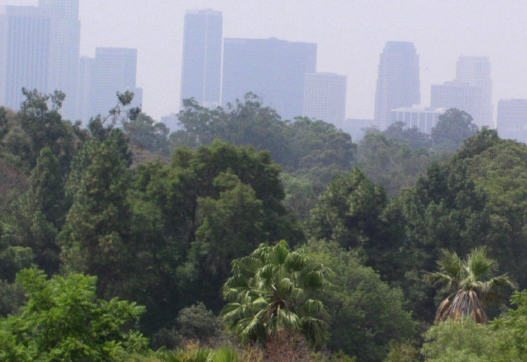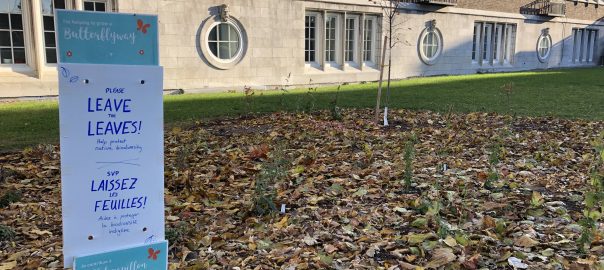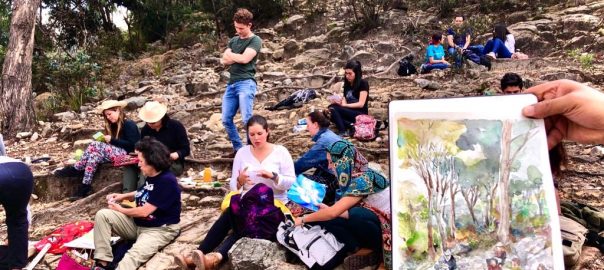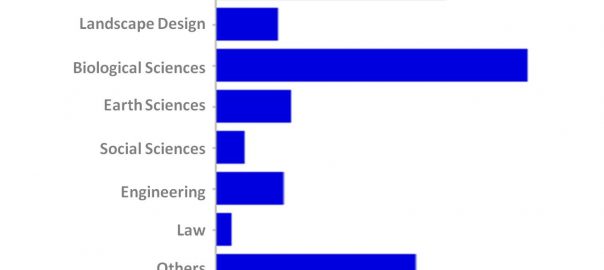This winter I had occasion to spend a few days in the city of Albuquerque, where it was cold, dry and brown. Winter in the Southwestern United States. Trees along the Rio Grande were bare; not too many trees elsewhere. Taking the taxi back home from the Los Angeles International Airport, fondly known as LAX, was almost a sensory overload, greenness everywhere in this Mediterranean climate: in median strips, in freeway interchanges, in cracks in sidewalks, along streets and in yards, feral weeds and selected plants. What irrigation and a benign climate can sustain is truly a wonder. Los Angeles has about 562 different tree species in the county, arguably one of the most biodiverse forests in the world, but virtually totally human created.
Such non-native tree diversity raises issues about what belongs, what doesn’t, and whether cities – almost entirely anthropogenic systems, including their urban vegetation – can be analyzed using conventional ecological science. I raise this as conventional ecosystem science has built in assumptions about processes that are derived from studying systems that evolved over a very long time. Are these assumptions adequate for anthropogenic ecosystems that are new? I don’t know, but surely worth some examination.

It is quite astonishing to drive around in L.A. and see what people have planted from around the world, from Australia, Latin America, Europe, Asia and North America. This riot of tree species, juxtaposed through human inspiration, raises provocative questions about concepts of biodiversity, conservation biology, and urban ecology. Is biodiversity a positive value in itself? If so, Los Angeles ranks very high on that index! Or is it indigenous biodiversity? In which case L.A. is far from the scrubby chaparral ecosystems and swamps that characterized its low lands, and the intermittent oak and black walnut forests of its alluvial fans. In this region, summer would be our equivalent of winter in the northern latitudes: plants shut down to survive rainless summers. Trees hug alluvial fans with accessible ground water, or the intermittent riparian corridors where water may have receded under ground. People chose to alter this native vegetation and landscape in the early Spanish colonial period, to introduce ceremonial and food bearing vegetation. As Anglo settlers came with their visions of Italy and Europe, with curiosity about plants in other parts of the world like Australia, Southern California was an excellent laboratory to experiment with new cultivars. Immigrants from east of the 100th meridian brought norms of landscaping, including lawns. Over a century and a half, the indigenous landscape was transformed to a lush, varied, and arguably seductive (but entirely new) set of plants and assemblages.
In LA, seasons be damned, lush green has been normalized as the quotidian landscape of the region. This is the new normal for Angelenos, and changing to something else will be difficult. It will be difficult because it takes time for expectations about normality to shift, and it will be difficult because there will have to be agreement about what the something else should be. Urban landscapes reflect history, culture and preferences – within the context of climate and geographical location. They are often far distant from the native ecosystems. Thus it is entirely legitimate to ask what kind of ecology is an urban one, as in cities, humans have came in, eradicated nearly all the native vegetation, transformed the soils and topography, and plunked a bunch of plants from around the world together because they liked them. Do these plant assemblages function in the same way as plant assemblages that evolved over millennia? Can the same tools be used to examine them?
Finally, there is the interesting development of ecosystem valuation. For cities this means developing metrics of the value of trees in cities for their carbon sequestration capacity, storm water mitigation, shading value to reduce the urban heat island and air pollution mitigation potential. For cities in the southwest – where there were no forests to begin with, and with urban trees from elsewhere – it will be important to balance these uncertain values with water requirements by trees. Again, the question of ecosystem science comes into play as much of the quantification of tree attributes in cities is based on average calculations of benefits from across the country. It all seems rather cobbled together in an effort to ensure that trees are planted in cities, rather than on careful examination of trees in situ. For I would argue, how well trees do in cities all depends – on soils, air pollution, watering regimes, pruning regimes, location and mostly on humans. Including the human element in urban ecology, still remains the frontier of research.
There is a temptation to naturalize urban systems, including their urban vegetation, but in the case of L.A. (and perhaps other cities too), perhaps we flip this on its head and humanize vegetation, asking why this type of planting, and how humans may impact its success. In the American Southwest, water is the key, and humans manage that asset. It will be a matter of choice whether the trees make it, versus lawns, or other values. Seasons will impact that choice only to the extent that summers become hotter and drier, or winters wetter and more violent. And that will depend on how the climate evolves, again a by-product of human decisions.











OBJECTIVE OF SUSTAINABLE SCIENTIFIC DEVELOPMENT
The objective of Sustainable Scientific Development is to make institutions influence both the environmental knowledge and the concept of phenomenological sustainability towards the technical activities that make a development for industrial productivity. Likewise, support will be sought with scientific universities to give a better understanding in their function of progressive activity to increase their viability to the knowledge of scientific development. The issue of sustainability for better practical and social benefits, is now recognizing their special benefit for regional plans are more profitable, to challenge a large percentage of the population still lives in poverty, Sustainability can never be achieved unless there is a will and significant political changes are made to understand sustainability in a conscious way. Therefore, it is recognized that the depletion of the natural environment because of poverty and conflict, the conflict caused environmental devastation and only with the recognition of human rights and democracy such conflicts can be avoided to allow environmental rights are respected And are fulfilled to create societies more advanced to the knowledge of sustainable development. Sustainability / sustainable development clearly outlines this range of interrelations and provides the appropriate framework for improvement. Recognition on Sustainable Development will allow through support or endorsement with scientific groups will increase considerably to the dissemination, understanding and internalization of these values and principles that aims to global sustainability, who are at the forefront of ideological knowledge; But this has not yet been translated into determination and political will necessarily to satisfy the demands that dangerously depend on a society with instinctive and bi-conscious perception between the triad context / environment / knowledge. Pedagogy Sustainable Development aims to harmonize into an ideological balance with the population, while the vision for the future that can renew the holistic commitment of the institutions, as a result of achieving what is intended to compensate environmental problems, but has also failed to engage the phenomenological framework, for this reason I intend to develop a research thesis by application ” Professor BTH is looking for a physical planning focusing on environmental science ” or ” Professor BTH is looking for a physical planning focusing on science Environment and health committee and community planner, ecological group and that will allow me to offer Karlskron case study on hermeneutics of specialized sustainability.
Sorry for my delayed response (which I’ll blame on travels), but as the saying goes, better late than never. So . . .
I read Stephanie’s blog posting with considerable interest for a couple of reasons. First, I lived in the LA megalopolis for six years (from the mid-1970s through the early 1980s). Back then, I didn’t pay as much attention to the nature of cities as I do now, so I didn’t really notice how many of the local plants were transplanted foreigners. I’m not sure I appreciated the diversity, either. When I wanted to spend time “in nature” I usually headed into the neighboring hills or mountains, or traveled to places like Joshua Tree NM, the Sierras, or the California Coast north of Ventura. I think such landscapes beyond the city felt intuitively more “natural,” more appealing to me. I now sometimes wonder how I “survived” six years in LA; it never felt like home and I always had a hard time with a lifestyle that seemed to demand spending so much time in my car, stuck in freeway traffic. But now I wonder if LA’s unnatural (i.e., non-native) ecology also played some role in my disconnection from the place.
Since 1982 I’ve lived in Anchorage, AK, a place sometimes dismissed by more rural Alaskans as “Los Anchorage.” It’s true that (as John McPhee once famously commented), parts of the city could be Anywhere, USA, places of malls, big-box stores, expansive parking lots, and snarled traffic. I tend to avoid such places and instead seek out Anchorage’s abundance of parks and trails and greenbelts and coastal flats, which, I’m happy to report, remain rich in native species. Of course some non-native plant species have taken a foothold, in many cases when people introduced fruit trees and “decorative” trees, bushes, and flowers. But there’s an increased recognition that at least some of these non-native species are invasives that could squeeze out or overwhelm some native plants, and efforts to minimize their spread. A substantial portion of the local population also recognizes the importance of protecting wild, native habitats. As someone who grew up exploring The Woods and the local neighborhood swamp along the edges of rural Connecticut, I’m delighted I can live in a city that retains much of its natural, native wildness, only a short distance from what some residents consider the “real” Alaska.
I am struck by the remark in the piece: “whether cities – almost entirely anthropogenic systems, including their urban vegetation – can be analyzed using conventional ecological science.”
What kind of assumptions are you thinking about? In community ecology we generally think of constellations of species (“communities”) being organized in ways that are governed by species specific relationships to environmental variables (the “niche”), and by patterns in competitive relationships and ordinary succession. For plants in urban settings, perhaps only the former is really in play.
As you point out, in urban settings such as LA, we control many of the environmental inputs (e.g., with irrigation), and we obviate many of the competitive moments among species (e.g., trees are often planted in tree pits alone, and as saplings, not seedlings, or are weeded).
For these reasons it seems to me that urban “communities” (of plants at least) are principally aggregations of individualistic responses to physiological forces — can the plant survive with the water, soil, and light that is available in the spot it finds itself in…generally where a person planted it — and not real natural communities at all, at least in the typical ecological sense. If so, then the study of these communities is all about plant physiology.
They are, though, aggregations of plant species that may support real communities of other organisms — say, birds and insects — with have more traditional ecological forces shaping their membership. And for which traditional ecological methods would be useful.
Stephanie, fortunately, in the Pacific NW, while your points are no less valid, Cascadian climate is far more benign and conducive to nurturing native vegetation as an integral element of the urban matrix and when dealing with questions of native vs non-native vegetation in restoration projects, ecosystem evaluation and valuation, and envisioning a future urban region largely dominated by native ecosystems. In our ecoregion, including the more urbanized portions of the Portland-Vancouver landscape, native still rules. I think this is largely because we still have a predominantly native flora, even in the heart of our urbanized area.
There have been many highly successful examples of non-native removal and replacement with native species. But, the long term success of these efforts may very well depend on the level of long term human management to which Phillip refers. I’ll be interested to hear what active restorationists from our region have to contribute. I’ll make a point of soliciting their views as well. One in particular, Dean Apostol, has written an excellent restoration text, Restoring the Pacific Northwest: The Art And Science of Ecological Restoration in Cascadia.
“… how well trees do in cities all depends… mostly on humans.”
Thanks, Stephanie, for emphasizing this point. I want to point out two (of many) ways of thinking about the overwhelming importance of humans in urban vegetation. “Non-native” or invasive urban plants thrive without much help from humans, though they initially hitched a ride with humans to colonize new cities. On the other hand, “native” or pre-settlement plant species often can’t get by without intensive watering, pruning, soil amendment, etc. They rely on human life support despite having once been endemic to that place. In either case, the social systems seem to have more to tell us about the ups and downs of urban vegetation than the plants themselves do.
It’s always a pleasure to get your perspective. I’m looking forward to more!